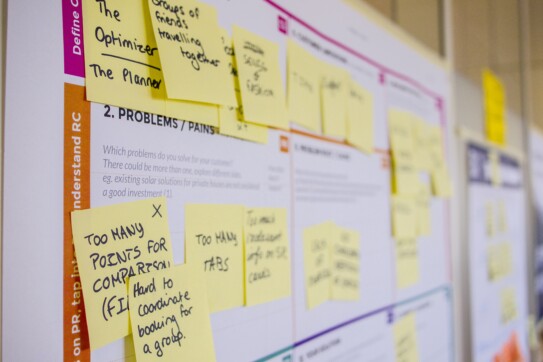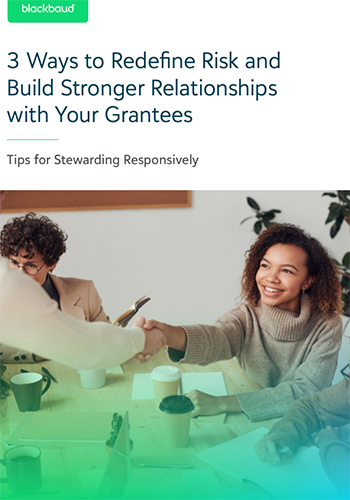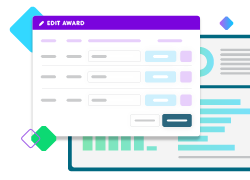The Unrecognized Risk of Status Quo Problem-Solving Skills for Grantmakers

In a sector that is so risk-averse—afraid of change, reluctant to explore new ideas, and adopt new practices—why do we rely on super risky problem-solving skills? Yes, we must steward our investments responsibly and ethically, but what is responsible and ethical about potentially wasting massive amounts of resources, using outdated problem-solving skills, and getting minimal impact for our efforts?
In her new book, No More Status Quo: A Proven Framework to Change the Way We Change the World, consultant Heather Hiscox, founder of Pause for Change and Possibility Project, discusses the problems with what she calls the “giant triangle of waste” problem-solving model and the risks it poses not only for the grantmaking organization, but also the organization’s relationships, resources, and reputation.
In this excerpt from No More Status Quo, Heather digs into the problematic assumptions of long-held “best practices” in the grantmaking space. She encourages us, as sector professionals, to rethink our outdated problem-solving habits and stop making assumptions without acknowledgment and testing.
The Funder’s Role in Risk
Funders—by which I mean donors, foundations, impact investors, and government agencies that grant financial support—disincentivize risk in a few ways. First, funders love and expect to see fully explained “giant triangles of waste.” In grant proposals and pitches, they want you to predict the future and show how, with your eloquent promises and plans for impact, you can best provide them the assurance of certainty. Most funders themselves use status quo problem-solving skills, so they expect you to do the same.
Further, funders disincentivize risk when they require lengthy applications and reports that may not always showcase reality or the organization’s ability to create impact. Most really good proposals and reports often better reflect an organization’s capacity to hire a great grant writer or marketing expert than their ability to do great work. Nonprofits show and share what worked, usually with tidy stories and charts. They know they can’t really share everything that happens behind the curtain (and believe me, there is so much that never reaches beyond the walls of most organizations) because they will risk the loss of funding. As of now, the sector has not widely adopted the enormous value of safely sharing learning, iteration, and pivots, so we rely on outward representations of seemingly all positive results.
Next, funders stunt risk with their beloved wait-and-see approach. Many funders want to wait to see how new models, programs, and leaders will perform, and they often require other funders to buy in before they will. As they wait, organizations, ideas, and potential progress suffer, and the riskier and newer a proposal feels, the more it is placed in the wait-and-see category. If the majority of funders adopt this approach, it is no surprise that large, established organizations that replicate the status quo receive the lion’s share of financial support. Where is there room for new, innovative, grassroots-led organizations that are often more creative, closer to the pain, and BIPOC-led?
Funders wield their power around risk in ways that are also unfair. I have witnessed how funders talk to one another and share missteps of organizations as a way to dissuade other funders from investing in them. While there is a time and place for holding organizations accountable for fiduciary and ethical violations, many organizations that do step out to try something new or that are transparent about what aspects go unexpectedly awry are “outed” and characterized as being a risky bet or less fundable. The information is often shared and received by another funder as an appreciated heads-up. I can guess this happens in every community, and it is frightening.
 Free Resource
Free Resource
Tips for Stewarding Responsively
3 Ways to Redefine Risk and Build Stronger Relationships with Your Grantees

Last, there is also an interesting dynamic where certain funders say they want risky and dynamic proposals but then when the call is answered, they are either disappointed or become fearful and retreat. For example, I was working with a small community foundation and they put out a call for “innovative proposals.” In year one, they received a small batch of submissions, and they were terribly disappointed. The foundation staff said things like, “These are similar to the proposals we usually get. Maybe our community doesn’t know how to think in bold, innovative ways.” They opened up the same mechanism in year two and received a stack of proposals with bold and innovative ideas. Their response in year two? “This feels a bit too out there,” and “How would they actually pull this off?” This example illustrates the power that funders hold in this dynamic between organizations trying to meet undefined goals and parameters of “innovation” and funders not matching their risk talk with their risk walk.
The Organization’s Role in Risk
Funders’ punitive behaviors and risk avoidance have trained organizations to avoid risk and bury failure, resulting in massive amounts of waste. One way this shows up is as a bizarre expectation and representation of perfection. Organizations play funders’ perfection game by writing grant proposals and making promises to funders as if they can predict the future. They say things like, “We will create X program, it will serve Y people, in Z months, and it will create these A, B, C forms of measurable impact,” but do they really know any of that?
I like to explain the expectation of perfection and denial of failure by talking about science. Imagine a scientist sitting in a laboratory, surrounded by chemicals and other solutions that are contaminant-free and highly controlled. With such care and precision, how many times do their experiments go as expected the very first time? Almost never, right? They nearly always have to tweak an amount, a setting, a hypothesis. But somehow, we as a sector are expected to get our solutions right the very first time. This sounds even more ridiculous when we acknowledge that we’re working with human beings who are infinitely complex, and we are operating in a space to address systems, structures, and practices that in many cases have been intentionally designed for hundreds of years to limit the possibilities and success of huge segments of our population. How does this make any sense, and why don’t we acknowledge that we, too, are testing hypotheses, and we need the skills, resources, and flexibility to test them?
Manage your entire grantmaking workflow, from online grant applications through payments
Find out how Blackbaud Grantmaking™ fits your organization.

Another way risk shows up on the organization side of the sector is through competition (although funders do also compete in their own ways). The sector has fully bought into the idea of scarcity and that there’s only so much proverbial pie to go around. Organizations continually operate in “not enough” mode and are expected to try to make the best of their limited resources and create (and evaluate) the most impact possible. If you match the dire and constant warnings of depleting dollars with the large number of existing and newly emerging organizations also vying for this limited funding, you get a paralyzing hot mess of fear and competition.
Because organizations believe they are operating in extreme austerity, it is even more imperative for them to hide missteps not only from funders but also from each other. They most definitely don’t want other competing organizations in their community to learn about their issues, as it would show weakness and could impact their competitive advantage. We rarely like to acknowledge the competitive nature of the sector, but it is beyond real, and competition is another dynamic that funders have created and now sustain with their flawed grantmaking structures.
One story I encountered on my journey will forever make me sick to my stomach. I was working with a coalition of organizations from one community that was working on a shared mission of supporting families. One day, a few of the team members told me about issues they were seeing among some of their sister agencies. They said two different agencies that served nearly the same area of town were competing for “clients.” One organization had the capacity to support community members, but they weren’t able to fill their open spots. As a result, they had less than satisfying reports to share with their funders and financial support was waning.
The other organization was over capacity. They had a waiting list and were not able to support everyone who contacted them. Rather than reaching out to the other agency and referring people to them, they were using this increased demand to their advantage and had tweaked their funding solicitations to use the language, “For every one community member we support, three more are waiting for services. Please help now.” Their donations were increasing and they were still struggling to meet the need.
If you examine these two experiences in isolation, you might say about the first organization, “Ah well, I guess there isn’t room for everyone in this community, and organizations that support fewer people should go by the wayside.” You might say about the second organization, “Wow! They are doing really great work and they need more help to meet demand. Let’s make a gift!” As you can see in this example, which is sadly probably not totally unique, some organizations are prepared to gamble with and neglect human needs in order to retain their position, power, and privilege.
Can you imagine what would happen if organizations could have trust-based relationships with their funders, board members, staff, and communities? What if they could be vulnerable, share where their plans had to diverge, or when their logic model was off? What if the unexpected wasn’t seen as failure but as lessons to be shared? What if these stories could be collected and shared across the sector?
Wouldn’t it be awesome if there was an open-source searchable database in which you could enter the idea you were having, say, “community garden,” and up would pop a treasure trove of learning? People could share what they had planned, what worked and what didn’t (and why), and what advice they would offer to others just starting on their journeys.
One day I would love to create an open-sourced learning database, but for now, in every community, organizations are literally working on the same missions, building and operating essentially the same programs, and they are not only not talking to one another but also actively hiding information from each other. How does that make sense if we are to make progress on awful and persistent social problems? The sector’s fears of risk and retribution and the dynamics of expected perfection and competition are hamstringing us and stalling progress and possibility.
